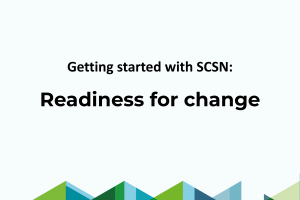Getting started with SCSN, Readiness for change

Change is an opportunity for growth
Previously, we shared the story of ISCAR Netherlands, a company that recently joined the SCSN network and has since become an ambassador. One key theme stood out in that interview: readiness for change.
What do we mean by that?
In short, readiness for change refers to the extent to which an individual or organization is open to change and actively willing to contribute to improvements.
Why change creates space for progress
Change often triggers resistance—not because people don’t want to adapt, but because they’re attached to familiar routines and certainties. This is known as loss aversion: we tend to weigh potential losses more heavily than possible gains.
Within organizations, this leads to questions like:
“Why change something that already works?”
“What will this cost in terms of time, effort, or control?”
These are valid and familiar concerns. But if they’re not openly addressed, they can unnecessarily slow down digitalization.
From doubt to trust: building a safe environment together
Many questions and concerns stem from uncertainty. Employees want to know what the change means for their work and roles. By communicating openly and involving people actively, you build trust and increase support for digital transformation.
It’s also important to create a safe environment where everyone feels free to ask questions and make mistakes without fear. This encourages learning and innovation, and helps ensure a smoother change process.
Using the power of habit for positive change
People are creatures of habit—they find comfort in routines. That’s why many organizations have used the same ordering processes, Excel sheets, and PDF invoices for years. These habits offer control, but also present opportunities to work smarter.
By reflecting on these routines and what they cost in terms of time, errors, and inefficiency, space for change emerges. Are we really working in the best possible way?
Digitalization is often less tangible than, say, a new machine or materials on the shop floor. Physical tools are easier to justify because their benefits are immediately visible. Digital tools, however, are just as valuable—and often have a more lasting impact.
Creating support: how to engage leaders and colleagues
Change often starts with leadership, but employees can also make a difference. Even if you’re not in a leadership role, you can help spark the conversation about digitalization by:
- Getting informed through service providers, ambassadors, or customers already using SCSN—or by contacting SCSN directly.
- Sharing concrete examples and facts about benefits like fewer errors, faster processing, and more time for customer interaction.
- Discussing ideas with colleagues who are open to innovation.
- Using inspiring success stories from other organizations and SCSN participants.
- Showing which partners are already connected, making it more tangible and relatable.
- Keeping the conversation open and respectful when addressing concerns and questions.
If it’s difficult to get leadership on board right away, start with colleagues or partners. As more people experience and share the benefits, motivation to involve management will grow naturally.
Building the Future
Being open to change is the first step toward digitalization. With SCSN, we’re creating an environment where innovation can thrive and processes become smarter. By embracing new possibilities and supporting one another, we take steps that make a difference—not just today, but well into the future. Together, we’re building a strong, future-proof supply chain.